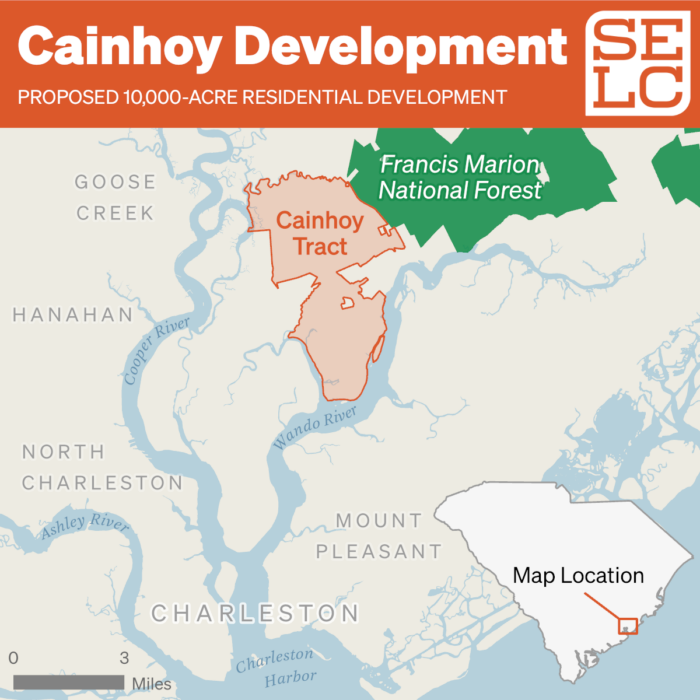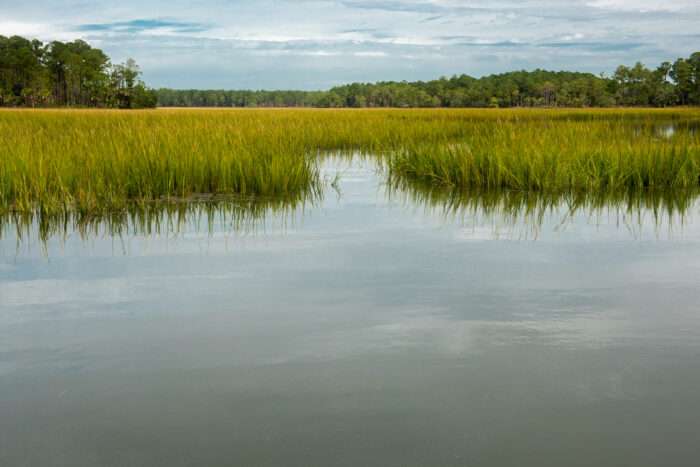Protecting Southern wetlands a key climate solution
Explore one of Charleston’s last undisturbed natural spaces.
The Cainhoy Peninsula is a critical area for flood-storing wetlands that help combat storm surge and rising seas. This is where developers are proposing to put thousands of homes.
When streets and yards are underwater on sunny days, there’s no denying flooding presents serious problems along our coast. What’s murkier, however, is how to handle these problems, caused by rising seas and stronger storms and made worse by outdated development practices.

As our coast becomes wetter, it’s also welcoming more and more residents, drawn to life by the water. This growth coincides with climate change, and wetlands are caught in the crosshairs—heralded for their ability to hold flood waters, yet seen as obstacles when development interests seek new land near desirable waterfronts. Already we’re losing wetlands at an alarming rate: the contiguous United States loses more than 80,000 acres of coastal wetlands every year, and 4 out of 5 of those acres are in the Southeast.
“It makes you ask, are we doing what is needed to address climate change on our coast?” said Chris DeScherer, Director of SELC’s South Carolina Office. “Or are we going to make an already difficult situation worse?”
Charleston’s Cainhoy conundrum
Putting these questions into focus are two projects unfolding in Charleston. Downtown, rising seas and increased flooding have pushed the city to seek answers from the U.S. Army Corps of Engineers. Their solution: an 8-mile seawall costing more than $1 billion surrounding the peninsula.

At the same time, officials are greenlighting a 9,000-acre development the size of a small city on a low-lying and flood-prone peninsula along the tidal Wando River. The massive Cainhoy project would forever change one of Charleston’s last undisturbed natural spaces, destroying flood-storing wetlands in the process.
Bordering the Francis Marion National Forest and home to species like the endangered Red-cockaded woodpecker, in many ways Cainhoy is one of the most ecologically important tracts of undeveloped land remaining on the South Carolina coast. Covering nearly half the property, Cainhoy’s wetlands act like a sponge, absorbing and holding waters along the peninsula’s edge. The land is teeming with wildlife and its surrounding waters host nature tourists in kayaks peering through the salt marsh beside small-scale fishers looking for crabs.
This is where developers are proposing to put thousands of homes, almost half of them in the floodplain, where floodwaters already show up during storms.
Better options

We knew there had to be a better plan for Cainhoy. To identify other options, SELC and our partners at the Coastal Conservation League engaged land planning experts to review the proposal. Their findings show that it’s possible to build the same number of homes on higher ground out of harm’s way—while cutting the number of impacted wetlands from hundreds of acres to a dozen.
When we showed those alternatives to the Corps during the permitting process, the Corps gave them little consideration. Now we’re suing in federal court to ensure they meet their responsibilities to consider “the least damaging alternative.”
“Even the Corps itself admits that there are smarter, more responsible alternatives,” said Senior Attorney Catherine Wannamaker, who is litigating our case. “Approving a huge new development in such a vulnerable area is completely at odds with ongoing efforts to protect the City of Charleston from flooding and storm surge that happens regularly now.”
What’s next?
The dilemma in Charleston mirrors what many other Southern cities are facing, or will face soon, as climate change increasingly impacts our ways of life. But when cities choose to fill wetlands, they remove an existing solution that could absorb the rising seas and are counterintuitively worsening flooding.
“As coastal communities face choices about how to adapt to a changing climate, the Cainhoy proposal is a reminder that nature provides us an obvious solution,” said DeScherer. “It’s sitting right outside our door, if we can just recognize it.”

